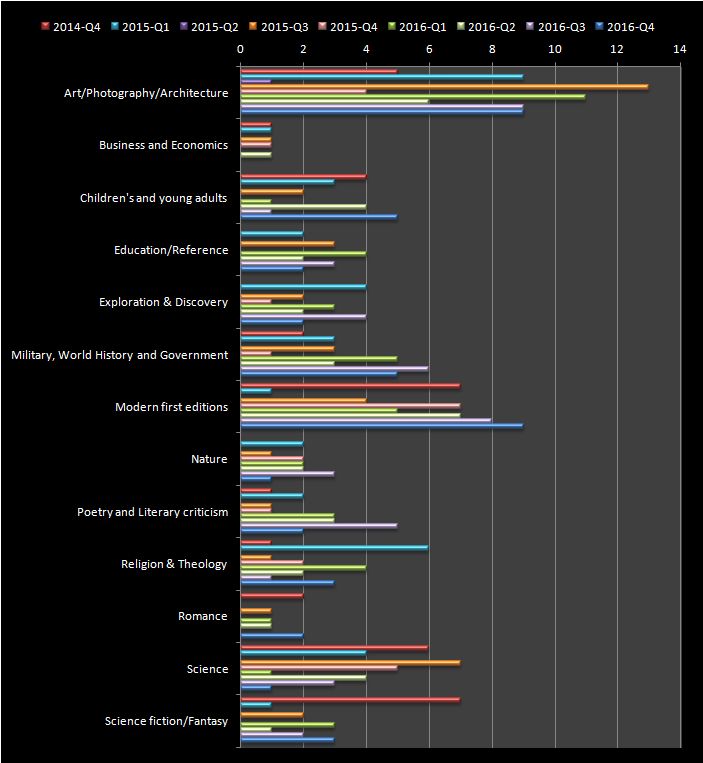 Last quarter’s coverage of the big rare book auctions, focused almost entirely on the new price record set by a first edition of Sir Isaac Newton’s Principia Mathematica, which has become the most expensive printed scientific book ever sold at auction after a winning bid of $3.7m (£3m), nearly two and a half times its highest estimate. In fact, the regular December 14 Christie’s event, “Fine Printed Books and Manuscripts, including Americana”, recorded close to 10 million dollars in total sales from 331 lots; a new record for this event.
Last quarter’s coverage of the big rare book auctions, focused almost entirely on the new price record set by a first edition of Sir Isaac Newton’s Principia Mathematica, which has become the most expensive printed scientific book ever sold at auction after a winning bid of $3.7m (£3m), nearly two and a half times its highest estimate. In fact, the regular December 14 Christie’s event, “Fine Printed Books and Manuscripts, including Americana”, recorded close to 10 million dollars in total sales from 331 lots; a new record for this event.
Exuberant sales such as the one for the copy of Principia Mathematica say nothing about the rare book market overall, or the broader market for the most common titles that make up the majority of sales. Record-breaking auction sales are meaningless to the Rare Book Sales Monitor (RBSM), which uses repeat sales data from a variety of sources including auctions, on-line marketplaces and book fairs to generate the reports. Repeat sales information exclude unique offerings that only sell once or the offerings that never find a buyer. In order to avoid nonsampling errors, (which can arise when a title being tracked is no longer trading within a year), it is replaced with another similar title of the same genre.
Within the results recorded towards the end of 2016, there was a wide disparity in performance. Titles that were extremely popular with collectors historically showed a significant drop in sale price or remained unsold, while others kept charging upwards. The differentiating attribute in most of these cases proved to be the factor of “condition”. A simple example to consider consists of two copies of the Hobbit by J.R.R. Tolkien, that are identical in every way, except one of them has had some restoration to the dust jacket. If the book without restoration to its dust jacket sells for 20% more a few months after the copy with the restoration did, a normal indexing process could record a 20% jump in one of its composites. Since collectors are more willing to pay the premium for the appeal of a copy that still has its original dust jacket condition intact, a statistical method called “hedonic regression” is applied to the computation, with the end result, in this case, having no price appreciation recorded. Hedonics is usually applied to titles that are sold with specified faults, such as damages or missing parts like dust jackets.
The RBSM begins by recording price changing trends in titles considered to be within very narrow homogeneous range. In other words, books having the same imprint and condition. Following that, consideration is given to special attributes, if any, such as signatures, inscriptions, associations, margin notes etc. The copy of the Hobbit, for example, that sold for a premium because it was signed by the author, made an impact on the author/genre RBSM index, because of the availability of comparables. Putting a price tag on “signature” is tricky, because it varies, as anything else, by author popularity and scarcity of work. Signature valuations are best left determined by the marketplace forces.
A less important consideration, but still a factor is the channel by which a particular title gets sold. Auctions in particular, are more vulnerable to wider sale price fluctuations or price variance. Bidding at an auction can become sensational given some participant rivalry, and may push sales beyond unprecedented levels. For this reason, the RBSM favors price changes recorded within similar channels or marketplaces. This heuristic practice is also in agreement with recent research studies at Stamford University, which imply that books in high demand which appear at auction more frequently, consist of works that sellers are willing to part with because they have increased in value. Such bias is minimized by comparing sales from the same channel.
The RBSM indexes are rough approximations, but they are still very useful. They are very good at providing a high level picture of the more general price trends for several genre and authors actively trading in the rare book marketplaces. In this respect, even though the media declared that a first edition of Principia Mathematica, set out Newton’s laws of motion in rare book trade motion, the RBSM recorded a significantly lower increase for the genre of science since the first quarter of 2016.


{ 0 comments… add one now }